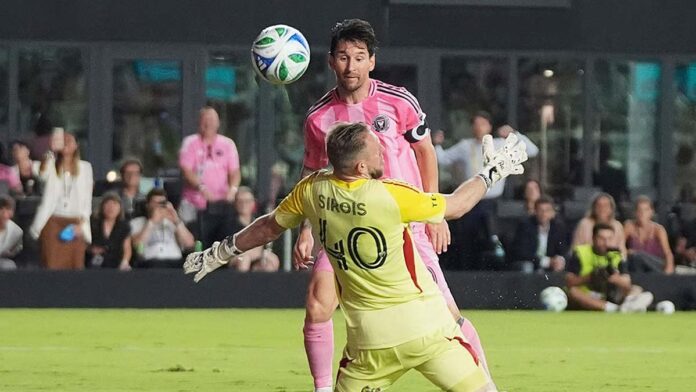1. Introduction: Stakes, Setting, and Form
Firstly, it’s important to set the scene. Entering the match at Stade Saputo on July 5, both teams carried contrasting narratives. Inter Miami, fresh from the Club World Cup and sitting mid-table in the Eastern Conference, needed momentum. Meanwhile, Montréal, anchored at the bottom, sought a spark under new interim coach Marco Donadel fotmob.com+10si.com+10khelnow.com+10. Consequently, the stage was set for drama.
Moreover, Inter Miami’s hefty payroll—sky-high thanks to Messi’s $20.4 M salary—contrasted sharply with Montréal’s modest $12 M budget . Yet, despite stellar resources, Miami’s recent MLS form had underwhelmed. Thus, expectations were high heading into Canada.
2. Recent Form: A Tale of Two Teams
Moving forward, context reveals insights. Inter Miami, still riding the Club World Cup hangover, returned to MLS after a shock 4–0 loss to PSG . Although that defeat was historic, they bounced back—a 4–2 win over Montréal just weeks prior, with Messi and Suárez both netting braces apnews.com+11as.com+11espn.in+11. In fact:
- Miami had scored seven goals in those earlier encounters.
- Yet inconsistency lingered: multiple injuries and squad rotation affected rhythm sportstar.thehindu.com+14essentiallysports.com+14aftonbladet.se+14.
On the other hand, Montréal endured a nightmare run: just one win in 15 MLS matches and clearance to move on after seven consecutive games without a victory . Under Donadel, there was renewed hope, but questions remained if they could handle Miami’s firepower.
3. Tactical Frameworks: How Each Side Set Up
Surprisingly, tactical planning mattered more than star power. Montréal opted for a 3-4-1-2, with fullbacks offering width and Josef Martínez absent due to injury as.com+15sportskeeda.com+15essentiallysports.com+15. In midfield, Wanyama and Choiniere anchored, offering control. However, injuries to key forwards (Coccaro, Opoku) hampered attacking threat khelnow.com+1timesofindia.indiatimes.com+1.
Conversely, Inter Miami maintained their 4-3-3 base, though missing Alba and others khelnow.com. Mascherano continued to build around the Messi–Suárez–Busquets axis, while newcomers like Gressel and Rojas looked to add energy.
4. The Match: Key Moments & Scoreline
Ultimately, the game mirrored their first clash. This latest meeting, unlike the first, ended 2–1 in favour of Montréal, a stunning reversal by the hosts.
- First Half: Montréal stunned Miami early. Reports indicate Dante Sealy pounced on defensive sloppiness, giving Montréal a lead. As a result, Miami struggled to impose itself despite Messi’s presence goal.com+2khelnow.com+2aljazeera.com+2espn.in+1mykhel.com+1.
- Messi’s Status: While he returned from a minor scare, he looked watchful—slightly subdued perhaps from Cup fatigue and previous hamstring issues .
- Second Half: Montréal felt confident. However, Miami shifted momentum—Busquets orchestrated midfield moves, and Messi nearly equalised.
- Late Drama: As tensions peaked, Montréal held on. The scoreline finalised at 2-1 in Montreal’s favour, a statement result.
Thus, Miami’s vauntedattacking depth was exposed, while Montréal capitalized on discipline and structure.
5. Individual Highlights
Turning to specifics:
- Lionel Messi: After his return, Lionel played cautiously but saw some chances. Yet the lack of bursts might signal fatigue .
- Luis Suárez: Silent this match; veteran off the bench but couldn’t find space.
- Busquets: Controlled tempo, but lacked service from wings.
- Montreal’s Defense: Commanding. With Sirois, Campbell, and Wanyama solidifying structure, they disrupted Miami’s attacks.
- Sealy & Loturi: Took their moments—Sealy scoring and Loturi finishing late.
Notably, Marco Donadel deserves credit. In his first full game as interim coach, he crafted a bold gameplan that contained Miami’s stars apnews.com+7sportstar.thehindu.com+7espn.in+7khelnow.com+4goal.com+4aljazeera.com+4aljazeera.com+4as.com+4fotmob.com+4en.wikipedia.org+1goal.com+1.
6. Turning Points & Tactical Tweaks
If we consider turning points:
- Early Montréal goal shifted the psychological balance.
- Miami’s injury fatigue—stemming from Club World Cup exertions—likely compromised pressing intensity.
- Messi’s near-trip early-second half sparked rallied hope, but defenders held firm.
Meanwhile, tactical adaptability mattered. Donadel’s adjustments—shifting to a defensive ultra-compact phase after the opener—proved decisive.
7. Broader Implications: Season Outlook
Furthermore, this upset has ripple effects:
- Inter Miami: Now risk missing playoffs if inconsistency persists. Their reliance on big-name signings must translate to stable performance sportstar.thehindu.com+7si.com+7essentiallysports.com+7.
- Montréal: The win could spark resurgence. With new coaching and improved recruitment (Coccaro, Vilsaint) en.wikipedia.org+1en.wikipedia.org+1, they may mount a spirited escape from the bottom.
Plus, this game highlights a core truth: MLS parity means star power alone doesn’t guarantee victory.
8. Upcoming Stakes & Next Matches
Looking ahead:
- Miami travels next to Columbus Crew—a potentially tough fixture. They’ll need quick recovery.
- Montréal may gain momentum facing NYCFC or Cincinnati. Extended league schedule offers a chance to build on momentum.
Meanwhile, international breaks loom large, with Messi called up for Argentina’s World Cup qualifiers—though rotation may reduce Club fatigue earlier.
9. Fan & Media Reactions
Public reaction was swift. Montréal fans celebrated a resurgence with pride. Meanwhile Miami discussions online criticized fatigue and tactical naiveté. Multiple outlets—Times of India, Al Jazeera, ESPN—highlighted Montréal’s resilience and Miami’s ongoing challenges .
Moreover, some analysts argued Miami must manage star load better, to thrive in linked competitions.
10. Conclusion: Lessons and Trajectories
In summary, this match was about transition:
- Firstly, star power matters—but it must align with stamina and structure.
- Secondly, tactical guts—under Donadel—can trump talent.
- Thirdly, schedule management is vital: travel, fatigue, and rotation matter.
Ultimately, Montréal’s boldness paid off, while Miami’s laboured display underlines why MLS remains unpredictable.













